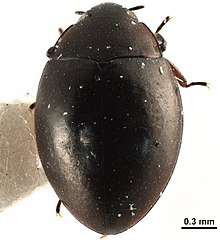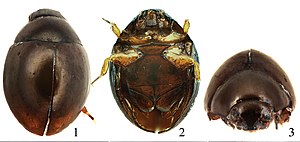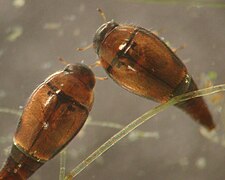Myxophaga is the second-smallest suborder of the Coleoptera after Archostemata, consisting of roughly 65 species of small to minute beetles in four families. The members of this suborder are aquatic and semiaquatic, and feed on algae.
| Myxophaga Temporal range: | |
|---|---|
 | |
| Satonius kurosawai (Torridincolidae) | |
| Scientific classification | |
| Domain: | Eukaryota |
| Kingdom: | Animalia |
| Phylum: | Arthropoda |
| Class: | Insecta |
| Order: | Coleoptera |
| Suborder: | Myxophaga Crowson, 1955 |
| Families | |
Hydroscaphidae | |
Description
Myxophaga have several diagnostic features: the antennae are more or less distinctly clubbed with usually fewer than nine segments, mesocoxal cavities are open laterally and bordered by a mesepimeron and metanepisternum, the hind wings are rolled apically in the resting positions. Internally, they are characterised by the presence of six malpighian tubules and the testes are tube-like and coiled.[1]
Beetles of this suborder are adapted to feed on algae. Their mouthparts are characteristic in lacking galeae and having a mobile tooth on their left mandible.[2]
Taxonomy
There are four extant families in the suborder Myxophaga divided between two superfamilies,[3] containing about 65 described species,[4] and at least one extinct family.[a]
Superfamily Lepiceroidea Hinton, 1936
- Family Lepiceridae Hinton, 1936
- Lepicerus Motschulsky, 1855
- †Lepiceratus Jałoszyński et al. 2020[5]
Superfamily Sphaeriusoidea Erichson, 1845
- Family Hydroscaphidae LeConte, 1874
- Hydroscapha LeConte, 1874
- Scaphydra Reichardt, 1973
- Yara Reichardt & Hinton, 1976
- Confossa Short, Joly, García & Maddison, 2015
- Family Sphaeriusidae Erichson, 1845
- Family Torridincolidae Steffan, 1964
- Claudiella Reichardt & Vanin, 1976
- Delevea Reichardt, 1976
- Iapir Py-Daniel, da Fonseca & Barbosa, 1993
- Incoltorrida Steffan, 1973
- Satonius Endrödy-Younga, 1997
- Torridincola Steffan, 1964
- Ytu Reichardt, 1973
Family †Triamyxidae Qvarnström et al. 2021
Unplaced in family
- †Leehermania Chatzimanolis et al. 2012[5]
Distribution
Living members of Lepiceridae are confined to northern South America and Central America. Members of Sphaeriusidae occur on all continents except Antarctica, while Hydroscaphidae occurs on all continents except Australia and Antarctica. Torridincolidae occurs in Africa, Asia, and South America.[10]
Fossil record
The fossil record of myxophagan beetles is sparse, likely due to their small size limiting preservation potential.[5] The currently oldest myxophagan is Triamyxa, described in 2021 from numerous specimens of found in a coprolite found in Late Triassic (Carnian) aged sediments in Poland. It was placed in its own monotypic family Triamyxidae, and was resolved as either the most basal myxophagan or sister to Hydroscaphidae.[9] The next oldest is Leehermania from the Late Triassic (Norian) Cow Branch Formation of North Carolina, which had previously been interpreted as the oldest known rove beetle but in 2019 was reinterpreted as an early diverging relative of the family Hydroscaphidae.[5] A fossil impression assigned to the living genus Hydroscapha in Hydroscaphidae is known from the Yixian Formation in the Jehol Biota, dating from the Early Cretaceous (Aptian).[11] Fossils from the early Late Cretaceous (Cenomanian) aged Burmese amber from Myanmar, have been assigned to the extant genus Lepicerus and extinct genus Lepiceratus within Lepiceridae,[12][13][14] as well as the extant Sphaerius and Bezesporum and the extinct Burmasporum and Crowsonaerius, belonging to Sphaerusidae.[7][8][6]
Gallery
- Specimen of Sphaerius minutus (Sphaeriusidae) in various views
- Specimens of Hydroscapha natans (Hydroscaphidae)
- Specimen of Lepicerus inaequalis (Lepiceridae)
See also
Notes
References
External links
- "Myxophaga". Atlas of Living Australia.
 Data related to Myxophaga at Wikispecies
Data related to Myxophaga at Wikispecies



